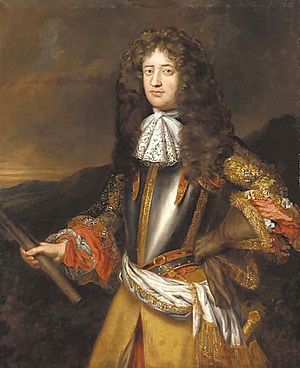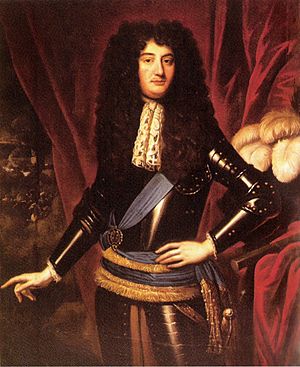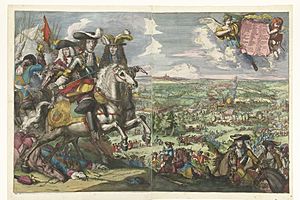George Douglas, 1st Earl of Dumbarton facts for kids
Quick facts for kids
The Earl of Dumbarton
|
|
|---|---|

Portrait by Henri Gascar
|
|
| Born | 1635 Douglas Castle |
| Died | 20 March 1692 St Germain-en-Laye, Paris, France |
| Buried |
Abbey of Saint-Germain-des-Prés
|
| Allegiance | |
| Service/ |
Infantry |
| Years of service | 1653 - 1688 |
| Rank | Major General Maréchal de camp |
| Unit | Régiment de Douglas or Dumbartons, later the Royal Scots |
| Commands held | Commander in Chief, Scotland May to 1686 |
| Battles/wars | Fronde 1648-1653 Franco-Spanish War 1653-1559 Third Anglo-Dutch War 1672-1674 Franco-Dutch War 1674-78 Argyll's Rising June 1685 |
| Awards | Knight of the Order of the Thistle |
Major-General George Douglas, 1st Earl of Dumbarton (1635 – 20 March 1692) was a Scottish military officer. He spent much of his career serving King Louis XIV of France.
In 1678, he came back to England. As a Catholic, he was a trusted helper of King James II. When James II lost his throne in the Glorious Revolution of 1688, George Douglas went into exile with him. He passed away in March 1692 at the palace of St Germain-en-Laye in France.
Contents
Early Life and Family
George Douglas, who later became the Earl of Dumbarton, was born in 1635. He was likely born at Douglas Castle in Lanarkshire, Scotland. He was one of 13 children born to the Marquess of Douglas and his second wife, Lady Mary Gordon.
During the 1630s, most people in Scotland were Protestants. Catholicism was mainly followed by some noble families, like George's parents, and in remote areas. The government in Scotland at the time, called the Covenanter government, wanted all Douglas children to be raised as Protestants. To avoid this, George was sent to France. He first appears in records in 1647, showing he had permission to travel there.
George and most of his close family remained Catholic. However, his older half-brother became a Protestant. His elder brother, William, also became a Protestant to marry a wealthy Presbyterian woman named Anne Hamilton.
George married Anne, the daughter of George Wheatley. They had one son who lived to adulthood, George Douglas, 2nd Earl of Dumbarton (1687-1749).
Military Career

After King Charles I was executed in 1649, many royal supporters lived in exile. They joined military units in other countries, like the Dutch Scots Brigade. These units were common, and soldiers often chose sides based on their religion or personal connections.
The Régiment de Douglas was one such unit. It was formed in 1633 and recruited in Scotland. This regiment had served with the French army for many years. In those days, regiments were like personal property of their Colonel and were very valuable. In 1645, ownership of the regiment went to the Earl of Angus, who stayed in Scotland. He then made George Douglas the Colonel in 1653.
During the Fronde, a civil war in France from 1648 to 1653, George's regiment was very important. As a foreign unit with Catholic officers, it was one of the few that the young King Louis XIV could truly trust.
However, later in the Franco-Spanish War, France allied with England against Spain. Many royal supporters in France, including the future King James II, switched sides. George's regiment was then given garrison duty to prevent its soldiers from leaving.
Service in England and France
In 1660, Charles II became King of Scotland and England again. In 1661, there was a small uprising by some Puritan groups. George Douglas's troops were sent to England, but the revolt was quickly stopped. His regiment then returned to France. This was because the English Parliament did not want to pay for a large standing army.
George stayed in France until 1678. He briefly returned during the Second Anglo-Dutch War (1664-1667). His unit was based at Chatham dockyard in England. The famous diarist Samuel Pepys met him and noted the "odd" sound of the Scottish march played by the drums. In 1667, after the Raid on the Medway, his regiment was accused of looting. They were ordered back to France, and many soldiers deserted while waiting for transport.
In October 1669, George was badly hurt in a duel. A duel was a fight between two people, usually with swords or pistols, to settle a dispute. His injuries were so serious that newspapers reported he had died.
Under a secret agreement called the Secret Treaty of Dover in 1670, England agreed to help France against the Dutch Republic. This included sending 6,000 troops for the French army. George Douglas's regiment was expanded to over 3,400 men to help with this. These troops mostly fought in the Rhineland to avoid fighting against English and Scottish soldiers who were serving with the Dutch.
However, the alliance with Catholic France was very unpopular in England. England left the war after the Treaty of Westminster in 1674. King Charles II still wanted money from France, so he encouraged George Douglas and other soldiers to stay in French service during the Franco-Dutch War (1672-1678).
In 1675, King Charles made him the Earl of Dumbarton and Lord of Ettrick. But these titles did not come with land or money, and George complained they cost him a lot. In 1677, King Louis XIV made him a Maréchal de camp, which was like a Lieutenant General in the French Army.

Return to England
In 1678, there was a lot of worry in England about the Catholic James (Charles II's brother) becoming king. This led to the Popish Plot, where many people were falsely accused of trying to kill Charles II. This was followed by the Exclusion Crisis (1678-1681), where some wanted to stop James from becoming king.
At the same time, the Franco-Dutch War ended. George Douglas's regiment was dismissed from the French army in June 1678. In January 1679, it was reformed and became known as the 'First Foot' in the English army. To avoid too much attention from Parliament, the regiment was sent to Ireland in 1680.
As a Catholic military leader who had served King Louis XIV for a long time, George Douglas was viewed with suspicion by a political group called the Whigs. He asked King Charles for money because of losses from the Test Act of 1678. This law prevented Catholics from holding certain public offices, including being a Colonel of a regiment. In reality, he still effectively led his regiment, and he was officially restored as Colonel in 1685.
England did not have a large standing army. So, units like George Douglas's regiment were important for training English and Scottish soldiers. The most important of these was the Dutch Scots Brigade, which included English and Scottish regiments serving William of Orange in the Netherlands.

In 1681, James was sent to Edinburgh, Scotland, as the Lord High Commissioner to the Parliament of Scotland. Over the next two years, he created a group of supporters called the Scottish Court Party. This group included Catholics like the Earl of Melfort and George Douglas, as well as supportive Protestants like George's brother, the Duke of Hamilton.
In August 1681, the Scottish Parliament passed the Succession Act. This law confirmed that kings had a divine right to rule, that the natural heir would become king "regardless of religion," and that everyone must be loyal to the king. However, while personal Catholicism was tolerated, the 1681 Scottish Test Act also required all public officials to swear loyalty to the King and promise to support the "true Protestant religion."
In 1683, there were rumors that George Douglas would replace the Protestant commander in Scotland. This might be why he was asked to lead a diplomatic mission to France in July. In 1684, King Charles paid him £1,500 as compensation for losses he faced because he was Catholic.

Later Years and Exile
James became king in February 1685. In June, George Douglas helped put down Argyll's Rising, a rebellion against the new king. He briefly served as Commander-in-Chief, Scotland. However, he was replaced in October by a Presbyterian leader. In return for his support, he received land that had been taken from a rebel. In 1687, he was one of the first members of the Order of the Thistle, a special Scottish order of knighthood.
After James II was removed from power in the Glorious Revolution of November 1688, George Douglas went with him into exile in France. George landed in Calais, France, on January 20, 1689. The exiled king paid him a pension.
George Douglas passed away at St Germain-en-Laye in March 1692. He was buried at the Abbey of Saint-Germain-des-Prés in France, alongside other members of his family.
See also
- Dumbarton's Drums



